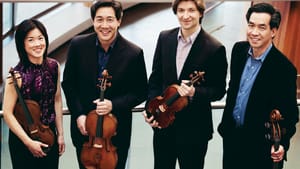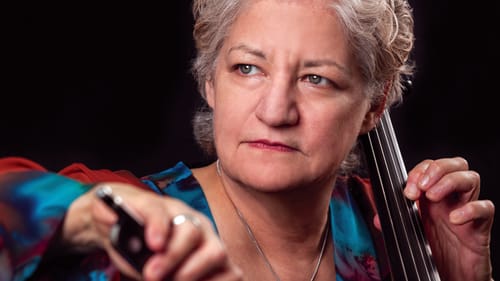Stay in the Loop
BSR publishes on a weekly schedule, with an email newsletter every Wednesday and Thursday morning. There’s no paywall, and subscribing is always free.
Two old masters and one new
The Philadelphia Chamber Music Society presents the Ying Quartet

Snow kept a few listeners away from the Kimmel Center on Sunday, but those who weathered the flakes reaped a harvest of pure pleasure thanks to the Ying Quartet, two guest musicians, and some thoughtful programming by the Philadelphia Chamber Music Society (PCMS).
The program included works by two 19th-century masters (Felix Mendelssohn and Johannes Brahms) and the Philadelphia premiere of Ingrid Arauco’s String Quartet No. 3, an imaginative work whose skillful string writing was ideally suited to the warm, sonorous tones of this much-loved ensemble. Arauco is also a professor of music at Haverford College.
Virtuoso voices
Founded in 1988, the Ying Quartet comprises four virtuosi with a single voice, including three siblings: Janet Ying, second violin; David Ying, cello; and Phillip Ying, viola. The group has had several first violinists in sequence over the years and could not do better than Robin Scott, who currently holds this position.
The quartet offered an electrifying reading of Mendelssohn’s String Quartet in D Major, Op. 44, No. 1, addressing the work’s challenges with a creative blend of flowing legato and gritty attacks. The melodic material floated with effortless abandon among the four instruments. Mendelssohn’s signature sunniness was in full evidence, but so were the moments of moody self-searching, as though the composer knew the next 10 years would be his last.

Each musician’s thoughtful personality shone through the four movements. I loved the way Scott’s eighth-notes solo in the menuetto danced wistfully above the sustained tones in the other instruments, a brief but affecting diversion in B minor. There are so many moments of exquisite loveliness throughout this work that we can understand (and more importantly, feel) why this work was a favorite of the composer.
Musical secrets
The quartet was similarly engaged in interpreting Arauco’s romantic String Quartet No. 3. The entire work is only around 16 minutes in length, but offers a musical experience of variety and intensity. There are some heavenly phrases in the short first movement, followed in the second movement by a monotonous repeated note in the cello, which proves to be a brilliant device to underscore the pining sonorities of the other instruments. It is quite amazing how David Ying manages to wrest so much feeling and flavor from that one note.
Following a playful third movement, the work concludes with a "Fantasia, Theme and Variations." This section begins with a duet between the two violins, joined by the other strings until they are sharing musical secrets among themselves in the spirit of four players on the same team.
The envy of music lovers
Following intermission, violist Kim Kashkashian and cellist Marcy Rosen joined the quartet for Brahms’s complex Sextet No. 2 in G Major, Op. 36. Kashkashian and Rosen are among the most highly regarded musicians on their instruments performing today, and brought an extra dimension of richness and insight into a work that is both demanding for the musicians and accessible to the audience.

This was especially evident in the last three movements, where the cohesion of the ensemble made it seem as though they had all been playing this together for years. I found the first movement just a bit rocky, with too soft a focus, as though the group was seeking its center. But this changed immediately in the scherzo (second movement) with near-perfect synchronicity. I love the way Brahms sprinkles pizzicato effects throughout this work, like raindrops, and in the second movement inserts a fiery presto giocoso reminiscent of the Hungarian dances he would complete a few years later.
Although each musician performed with impeccable technique and insight, it was impossible not to single out the role of Scott and David Ying as the lodestars grounding the navigation, high and low. Between these poles, all the musicians individually expressed their unique vision, becoming a single voice filled with subtlety and conviction. It is no wonder PCMS is the envy of music lovers throughout the nation for the high caliber and accessibility of its large concert series.
What, When, Where
The Ying Quartet, with guest artists Kim Kashkashian, viola; and Marcy Rosen, cello. Felix Mendelssohn, String Quartet in D Major, Op. 44 no. 1; Ingrid Arauco, String Quartet No. 3; Johannes Brahms, Sextet No. 2 in G Major, Op. 36. Philadelphia Chamber Music Society. January 13, 2019, at the Kimmel Center’s Perelman Theater, 300 S. Broad Street, Philadelphia. (215) 569-8080 or pcmsconcerts.org.
Sign up for our newsletter
All of the week's new articles, all in one place. Sign up for the free weekly BSR newsletters, and don't miss a conversation.

 Linda Holt
Linda Holt